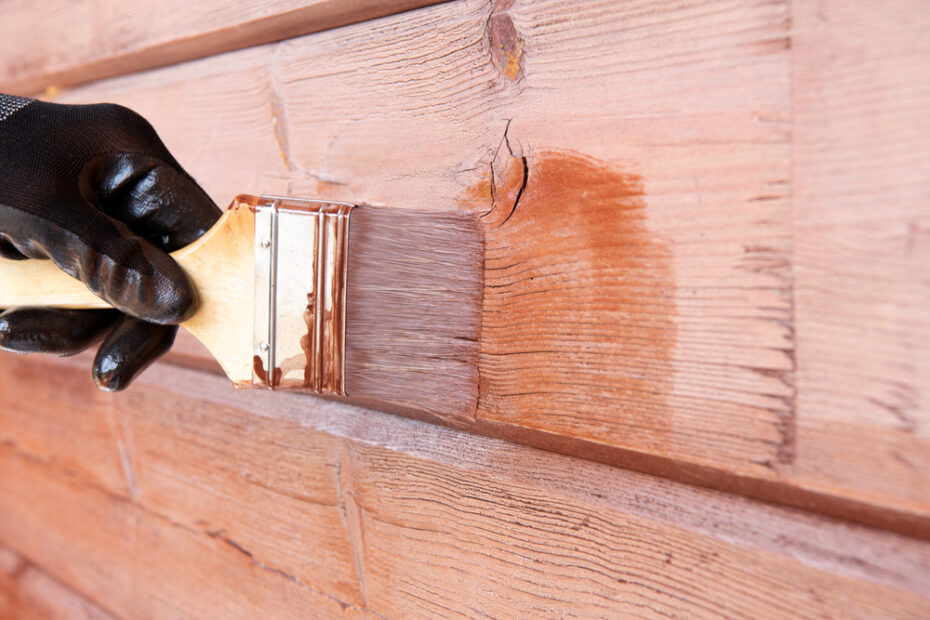Gone are the days when log home stains were available in shades of brown only. Today’s manufacturers offer a wide range of colors, from forest green to ocean blue—even pumpkin orange. All these shades are inspired by nature, making your log structure look as natural as possible.
How to choose the right stain for your log cabin?
Well, there is no hard and fast rule to choose the right stain. This is because certain factors ultimately determine the performance of your stain in the long run. Some of these factors are the proper surface prep and the amount of moisture present in the logs.
Above all, there are pros and cons to every finish. Some might penetrate more deeply while others ensure more UV protection.
Generally, log home stains are available in three formulations—water-based, oil-based, and emulsions (which is the blend of the two).
The point is here that choosing the right stain for your log cabin is not that simple. You have to consider several factors. But that doesn’t mean choosing the right log stain should be intimidating and stressful.
That’s why we have come up with this brief guide to help you choose the right stain for your log cabin.
Perform a Patch Test:
Whether you are re-staining or applying stain to your bare logs for the very first time, each new coat of stain on the logs makes the original wood color and grain definition less noticeable.
While you can add more layers of stain, but once a layer is applied, the color cannot be lightened at the end.
Therefore, make sure to perform a patch test before anything else. Just test it on a small area on your log before applying it to the entire home. Let it dry before applying another test layer.
This way, you can figure out what a single coat will look like when dry. It helps you determine which stain can go well with your log cabin.
Choose Between Oil Based and Water Based Stain:
This is an important step while choosing a suitable log stain. Wood is a natural material that contracts and expands. You need to choose a stain that won’t crack with those “organic” changes to your logs.
Most oil based penetrating stains are plant oil based and cause black mildew to form over time from dust and pollen sticking to them. This happens because oil based stains do not get a hard shell. Oil based stains also trap moisture in the wood. Among the professionals, oil based stains are generally avoided.
Water-based latex (like Gortex), they are flexible and elastic. It means that your stain will stay strong and durable while letting moisture out but not allowing rain in.
Choose the Compatible Stain with other Material:
Make sure that your stain is compatible with other materials and finishes. For example, most chinking products are water-based and work only with water-based stains.
Choose a Good Log Stain Color:
Choosing a stain color is purely based on your preferences and aesthetic sense. You are likely to choose colors that can reflect your tastes. But you should choose them carefully.
Light color stains give a brighter and natural look while dark colors are cozy and intimate. Or you can mix and match both shades.
Choose the colors you can live with for years to come. Otherwise, changing colors is not as easy as reapplying wallpaper or repainting drywall.
Understand the Difference between Interior and Exterior Stains
It is also important to understand the differences between interior and exterior stains. Given that exterior walls are exposed to weather and dirt, certain chemicals are often added to ensure protection from UV, fading, fungi, mold, or mildew. Although your indoor walls don’t require these additives, UV protection is recommended for your sunroom or any room with lots of windows. Stains without additives are less costly and less toxic.
What about Your Tools?
If you use a brush to apply a stain, the results will look slightly different than staining done with a sprayer. A beginner should stick with the brush. Brushing can help fill the marks. If you still want to use a sprayer, make sure to go over the coat with the brush to maintain even coverage and good adhesion.
How Often Should You Stain Your Log Cabin?
Any good quality log home stain needs maintenance every 3 to 4 years, if you go longer it can get costly to strip it and start over.
There is also a golden rule to check if you need to stain again. Just compare your most weather-affected wall to the least-affected wall. If you can see a stark color difference, it is time to recoat them.
The Bottom Line:
You must consider several factors to choose the right stain for your log cabin. Choosing the right stain not only makes your log cabin look attractive but also helps you protect your home. What do you think? Let us know by commenting below!
Browse some of our log home repair questions from log home owners like you.
Question 1 | Question 2 | Question 3
What do you think? Let us know by commenting below!
See you soon,

